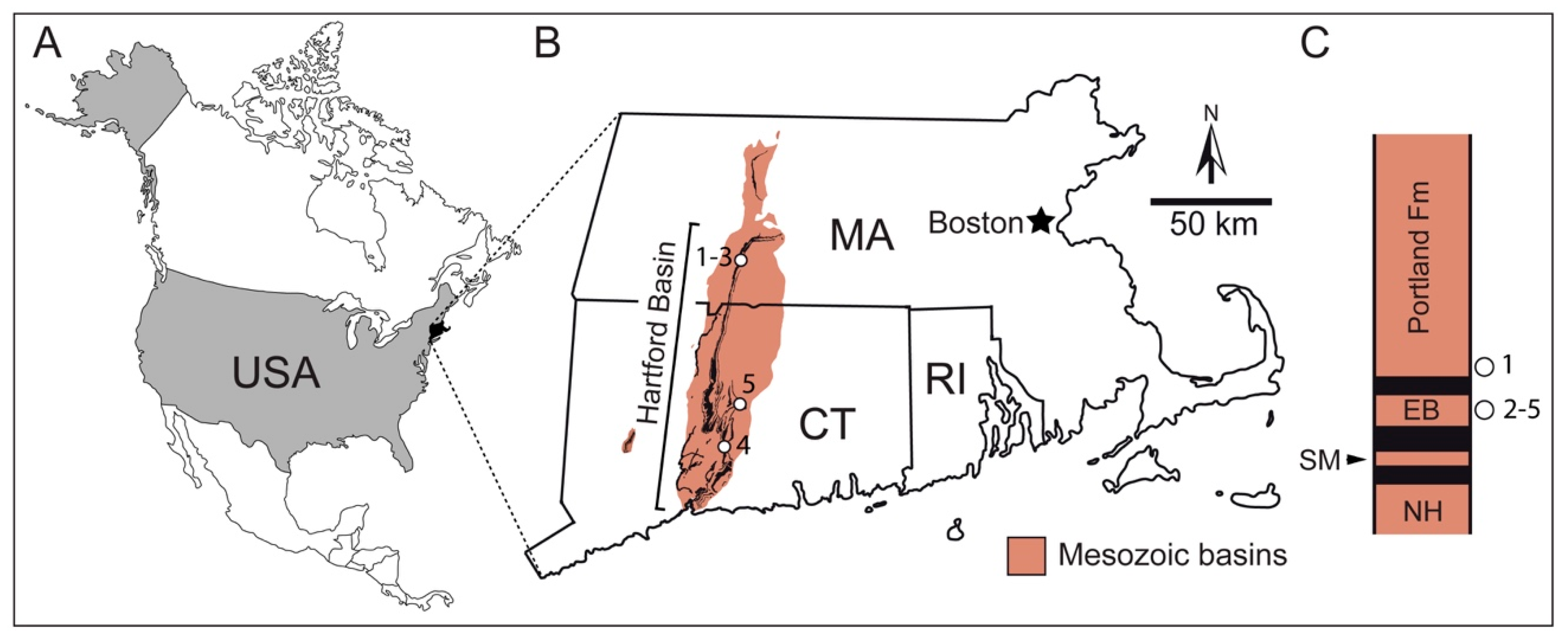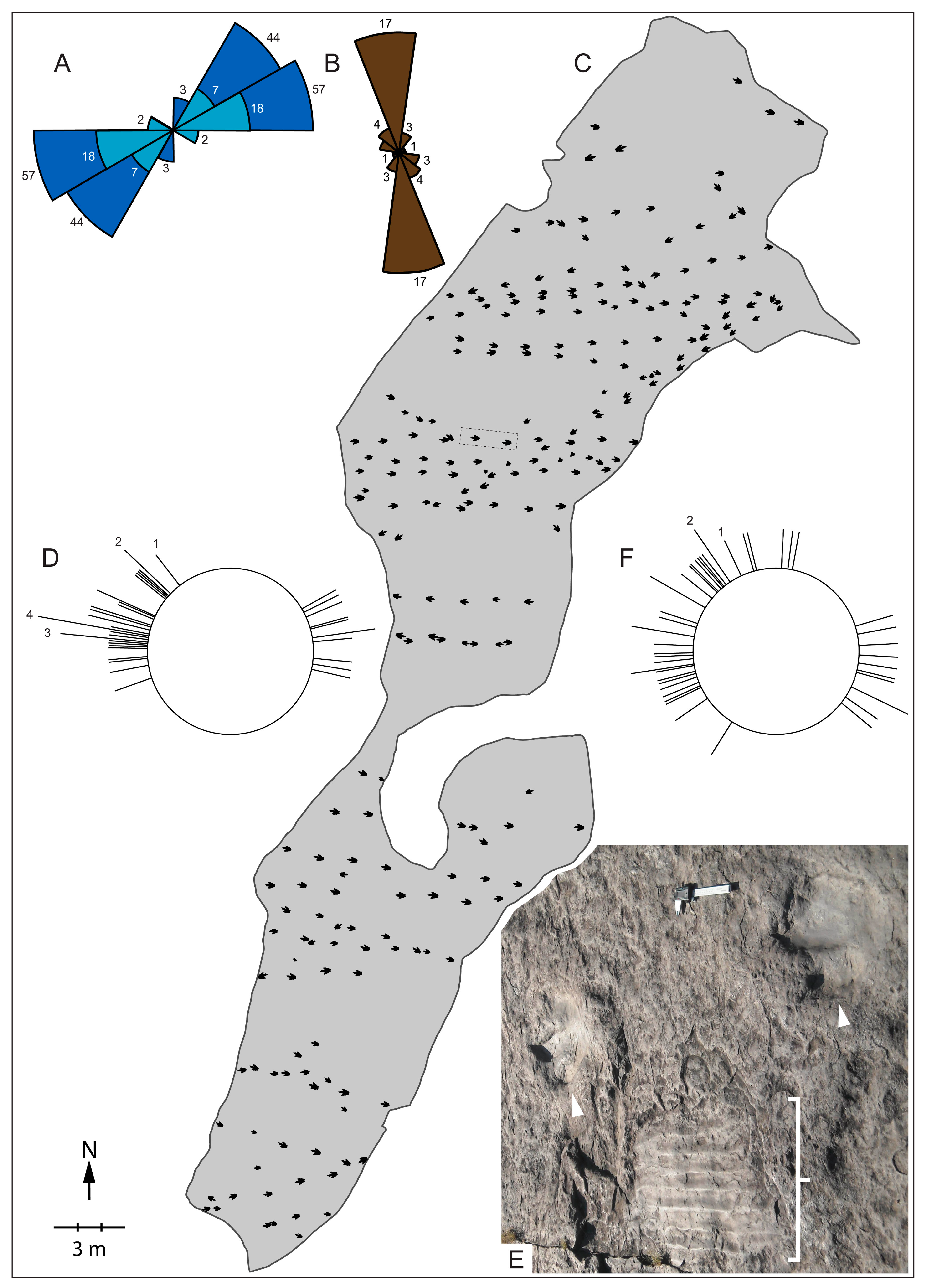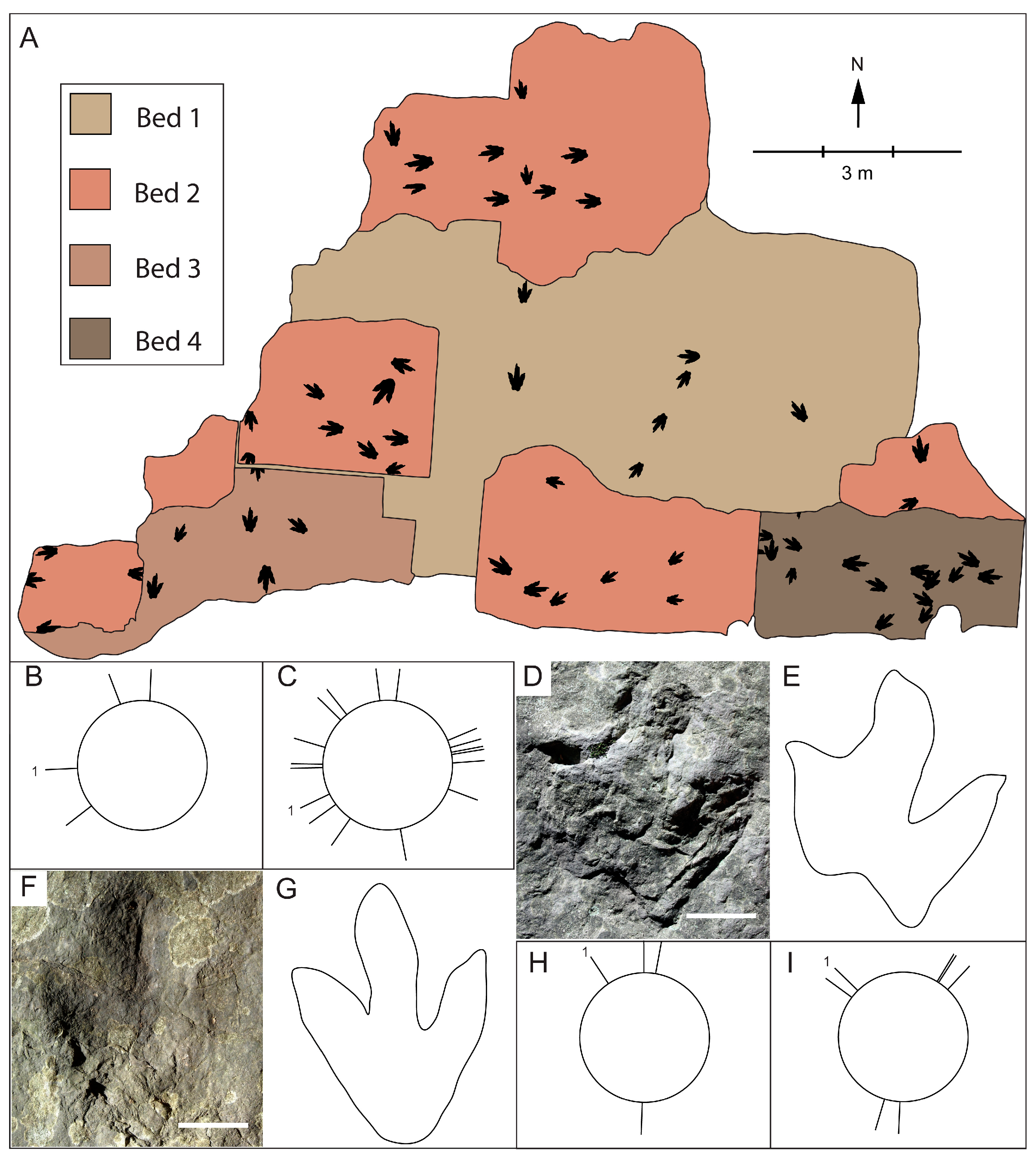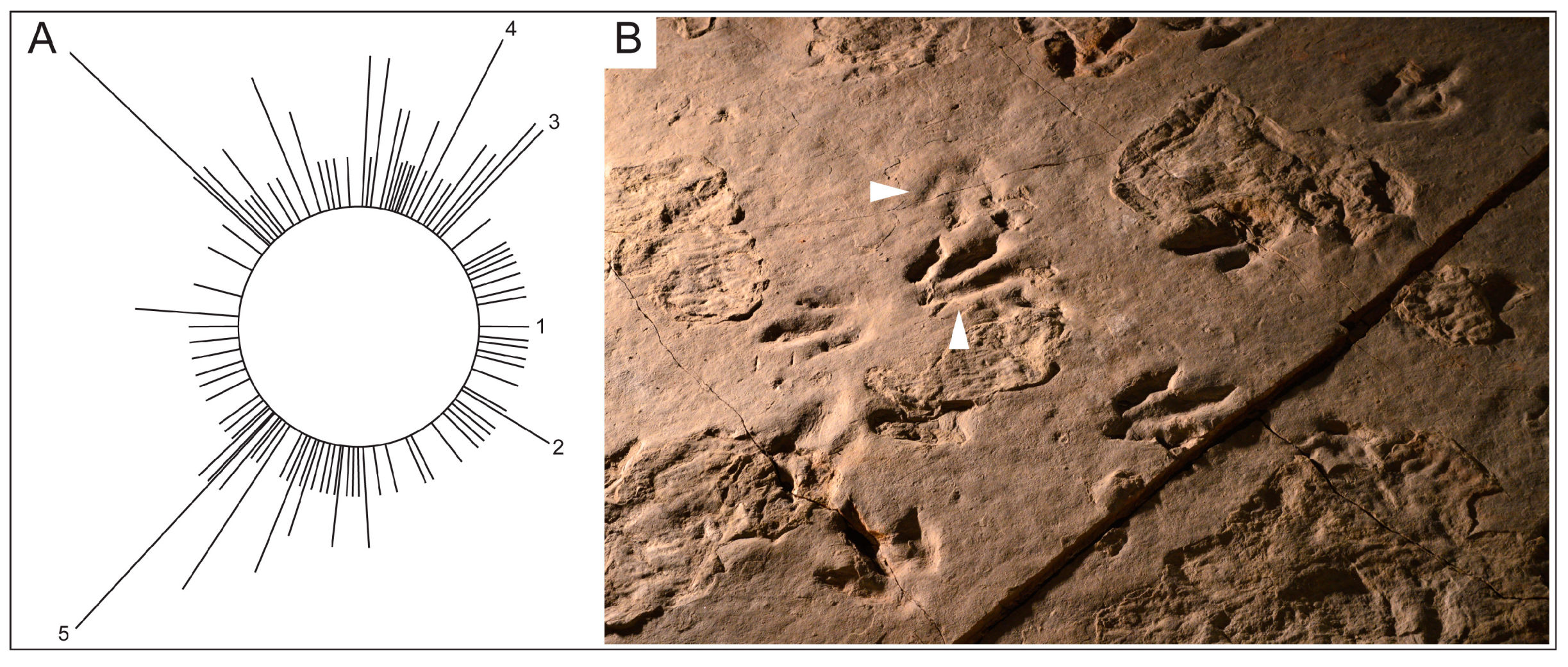Perennial Lakes as an Environmental Control on Theropod Movement in the Jurassic of the Hartford Basin
Abstract
:1. Introduction
2. Geological Context
3. Materials and Methods
3.1. Dinosaur Track Identification, Ichnotaxonomic Assignment, and Track Depth
3.2. Tracksite Mapping
3.3. Estimating the Number of Individuals
3.4. Orientation of Sedimentary Structures and Tracks
3.5. Statistical Analysis and Rose Diagram Construction
4. Site Descriptions and Trackway Orientations
4.1. Dinosaur Footprint Reservation
4.2. William Murray Quarry
4.2.1. In Situ Tracks
4.2.2. Tracks on Excavated Slabs
4.3. Gary Gaulin Dinosaur Tracksite
4.4. Powder Hill Dinosaur Park
4.5. Dinosaur State Park
5. Discussion
5.1. Trackways and Sedimentary Structures at Dinosaur Footprint Reservation
5.2. Trackways and Sedimentary Structures at Other Study Sites
5.3. Eubrontes giganteus Parallelism and the Hypothesis that the Trackmaker Was a Sauropodomorph
6. Conclusions
Acknowledgments
Author Contributions
Conflicts of Interest
Abbreviations
| DFR | Dinosaur Footprint Reservation |
| DSP | Dinosaur State Park |
| WMQ | William Murray Quarry |
| GGT | Gary Gaulin Tracksite |
| PHDP | Powder Hill Dinosaur Park |
References
- Hitchcock, E. Ornithichnology—Description of the foot marks of birds (Ornithichnites) on New Red Sandstone in Massachusetts. Am. J. Sci. 1836, 29, 308–340. [Google Scholar]
- Ostrom, J.H. Were some dinosaurs gregarious? Palaeogeogr. Palaeoclimatol. Palaeoecol. 1972, 11, 287–301. [Google Scholar] [CrossRef]
- Razzolini, N.L.; Oms, O.; Castanera, D.; Vila, B.; dos Santos, V.F.; Galobart, À. Ichnological evidence of megalosaurid dinosaurs crossing Middle Jurassic tidal flats. Sci. Rep. 2016, 31494. [Google Scholar] [CrossRef] [PubMed]
- Moratalla, J.J.; Hernán, J. Probable palaeogeographic influences of the Lower Cretaceous Iberian rifting phase in the Eastern Cameros Basin (Spain) on dinosaur trackway orientations. Palaeogeogr. Palaeoclimatol. Palaeoecol. 2010, 295, 116–130. [Google Scholar] [CrossRef]
- Lockley, M.G.; Houck, K.J.; Prince, N.K. North America’s largest dinosaur trackway site: Implications for Morrison Formation paleoecology. Geol. Soc. Am. Bull. 1986, 97, 1163–1176. [Google Scholar] [CrossRef]
- Castanera, D.; Barco, J.L.; Díaz-Martínez, I.; Gascón, J.H.; Pérez-Lorente, F.; Canudo, J.I. New evidence of a herd of titanosauriform sauropods from the lower Berriasian of the Iberian range (Spain). Palaeogeogr. Palaeoclimatol. Palaeoecol. 2011, 310, 227–237. [Google Scholar] [CrossRef]
- Currie, P.J. Hadrosaur trackways from the lower Cretaceous of Canada. Acta Palaeontol. Pol. 1983, 28, 63–73. [Google Scholar]
- Cotton, W.D.; Cotton, J.E.; Hunt, A.P. Evidence for social behavior in ornithopod dinosaurs from the Dakota Group of northeastern New Mexico, USA. Ichnos 1998, 6, 141–149. [Google Scholar] [CrossRef]
- Barco, J.L.; Canudo, J.I.; Ruiz-Omeñaca, J.I. New data on Therangospodus oncalensis from the Berriasian Fuentesalvo tracksite (Villar del Río, Soria, Spain): An example of gregarious behaviour in theropod dinosaurs. Ichnos 2006, 13, 237–248. [Google Scholar] [CrossRef]
- Castanera, D.; Pascual, C.; Razzolini, N.L.; Vila, B.; Barco, J.L.; Canudo, J.I. Discriminating between medium-sized tridactyl trackmakers: Tracking ornithopod tracks in the base of the Cretaceous (Berriasian, Spain). PLoS ONE 2013, 8, e81830. [Google Scholar] [CrossRef] [PubMed]
- Lockley, M.G. Tracking Dinosaurs: A New Look at an Ancient World; Cambridge University Press: New York, NY, USA, 1991. [Google Scholar]
- Getty, P.R. Excavated and in situ dinosaur footprints from the Murray Quarry (Early Jurassic, East Berlin Formation), Holyoke, Massachusetts, USA. Ichnos 2005, 12, 163–178. [Google Scholar] [CrossRef]
- Getty, P.R.; Hardy, L.; Bush, A.M. Was the Eubrontes track maker gregarious? Testing the herding hypothesis at Powder Hill Dinosaur Park, Middlefield, Connecticut. Bull. Peabody Mus. Nat. Hist. 2015, 56, 95–106. [Google Scholar] [CrossRef]
- Olsen, P.E. On the use of the term Newark for Triassic and Early Jurassic rocks of eastern North America. Newsl. Stratigr. 1978, 7, 90–95. [Google Scholar]
- Olsen, P.E.; McDonald, N.G.; Huber, P.; Cornet, B. Stratigraphy and paleoecology of the Deerfield Rift Basin (Triassic–Jurassic, Newark Supergroup), Massachusetts. In Guidebook for Field Trips in the Connecticut Valley Region of Massachusetts and Adjacent States, Volume 2, Proceedings of the New England Intercollegiate Geology Conference, Amherst, MA, USA, 9–11 October 1992; Robinson, P., Brady, J.B., Eds.; University of Massachusetts: Amherst, MA, USA, 1992; pp. 488–535. [Google Scholar]
- Withjack, M.O.; Schlische, R.W.; Olsen, P.E. Diachronous rifting, drifting, and inversion on the passive margin of central eastern North America: An analog for other passive margins. Am. Assoc. Pet. Geol. 1998, 82, 817–835. [Google Scholar]
- Olsen, P.E.; Kent, D.V. Long-period Milankovitch cycles from the Late Triassic and Early Jurassic of eastern North America and their implications for the calibration of the Early Mesozoic time-scale and the long-term behaviour of the planets. Philos. Trans. R. Soc. Lond. A 1999, 357, 1761–1786. [Google Scholar] [CrossRef]
- Olsen, P.E.; Kent, D.V. High-resolution early Mesozoic Pangean climactic transect in lacustrine environments. Zentralbl. Geol. Paläont. A 2000, 1998, 1475–1495. [Google Scholar]
- McDonald, N.G. Paleontology of the early Mesozoic (Newark Supergroup) rocks of the Connecticut Valley. Northeast. Geol. 1992, 14, 185–200. [Google Scholar]
- Olsen, P.E. A 40-million-year lake record of early Mesozoic orbital climactic forcing. Science 1986, 234, 842–848. [Google Scholar] [CrossRef] [PubMed]
- Getty, P.R.; Fox, N. An isolated Eubrontes giganteus trackway from the Gary Gaulin dinosaur track site (Early Jurassic, East Berlin Formation), Holyoke, Massachusetts. Northeast. Geosci. 2015, 33, 16–21. [Google Scholar]
- Olsen, P.E. Field Guide for non-marine boundary events in the Newark Basin (New Jersey, Pennsylvania, and Connecticut), eastern United States and their litho-, chrono-, and biostratigraphic context. In Proceedings of the International Geological Correlation Project 458, Orangeburg, NY, USA, 7–12 June 2002; State University of New York: Cortland, NY, USA; Columbia University: New York, NY, USA, 2002; pp. 1–181. [Google Scholar]
- Olsen, P.E.; Smith, J.B.; McDonald, N.G. Type material of the type species of the classic theropod footprint genera Eubrontes, Anchisauripus, and Grallator (Early Jurassic, Hartford and Deerfield Basins, Connecticut and Massachusetts, USA). J. Vert. Paleol. 1998, 18, 586–601. [Google Scholar] [CrossRef]
- Nichols, G. Sedimentology & Stratigraphy; Blackwell Science: Malden, MA, USA, 1999. [Google Scholar]
- MacDonald, D.I.M.; Jefferson, T.H. Orientation studies of waterlogged wood: A paleocurrent indicator? J. Sediment. Petrol. 1985, 55, 235–239. [Google Scholar]
- Hammer, Ø.; Harper, D.A.T.; Ryan, P.D. PAST: Paleontological statistics software package for education and data analysis. Palaeontol. Electron. 2001, 4, 9. Available online: http://palaeo-electronica.org/2001_1/past/past.pdf (accessed on 30 January 2017). [Google Scholar]
- Getty, P.R.; Judge, A.; Csonka, J.; Bush, A.M. Were Early Jurassic dinosaurs gregarious? Reexamining the evidence from Dinosaur Footprint Reservation in Holyoke, Massachusetts. In Guidebook for Field Trips in Connecticut and Massachusetts, Proceeding of the 47th Annual Meeting of the Northeastern Section of the Geological Society of America, Hartford, CT, USA, 18–20 March 2012; Thomas, M.A., Ed.; State Geological and Natural History Survey of Connecticut: Hartford, CT, USA, 2012; pp. A1–A18. [Google Scholar]
- Smith, J.B.; Smith, J.R.; Sweeny, J.P. Mt Tom revisited: A new fossil horizon at Dinosaur Footprint Reservation, Northampton, Massachusetts. J. Vert. Paleol. 1996, 16, 67A. [Google Scholar]
- Thibodeau, K.N. Images of America: Holyoke: The Skinner Family and Wistariahurst; Arcadia Publishing: Charleston, SC, USA, 2005. [Google Scholar]
- Demicco, R.V.; Gierlowski-Kordesch, E. Facies sequences of a semi-arid closed basin: The Lower Jurassic East Berlin Formation of the Hartford Basin, New England, USA. Sedimentology 1986, 33, 107–118. [Google Scholar] [CrossRef]
- Dalman, S.G.; Weems, R.E. A new look at morphological variation in the ichnogenus Anomoepus, with special reference to material from the Lower Jurassic Newark Supergroup: Implications for ichnotaxonomy and ichnodiversity. Bull. Peabody Mus. Nat. Hist. 2015, 54, 67–124. [Google Scholar] [CrossRef]
- Getty, P.R.; McCarthy, T.D.; Hsieh, S.; Bush, A.M. A new reconstruction of continental Treptichnus based on exceptionally preserved material from the Jurassic of Massachusetts. J. Paleol. 2016, 90, 269–278. [Google Scholar] [CrossRef]
- Dalman, S.; Lucas, S. Lower Jurassic arthropod resting trace from the Hartford Basin of Massachusetts, USA. Ichnos 2015, 22, 177–182. [Google Scholar] [CrossRef]
- Atkins, T. History of Middlefield and Longhill; Case, Lockwood, and Brainerd: Hartford, SC, USA, 1883. [Google Scholar]
- Ostrom, J.H. Peabody paleontologists assist new dinosaur-track park. Discovery 1967, 2, 21–24. [Google Scholar]
- Lockley, M.G.; Gillette, D.D. Dinosaur tracks and traces: An overview. In Dinosaur Tracks and Traces; Gillette, D.D., Lockley, M.G., Eds.; Cambridge University Press: New York, NY, USA, 1989; pp. 3–10. [Google Scholar]
- Farlow, J.O.; Galton, P.M. Dinosaur trackways of Dinosaur State Park, Rocky Hill, Connecticut. In The Great Rift Valleys of Pangea in Eastern North America; Letourneau, P.M., Olsen, P.E., Eds.; Columbia University Press: New York, NY, USA, 2003; pp. 248–263. [Google Scholar]
- Galton, P.M.; Farlow, J.O. Dinosaur State Park, Connecticut, USA: History, footprints, trackways, exhibits. Zubía 2003, 21, 129–173. [Google Scholar]
- McDonald, N.G. Window into the Jurassic World; Friends of Dinosaur State Park and Arboretum: Rocky Hill, VT, USA, 2010. [Google Scholar]
- Coombs, W.P. Swimming ability of carnivorous dinosaurs. Science 1980, 207, 1198–1200. [Google Scholar] [CrossRef] [PubMed]
- Colbert, E.H. The Triassic dinosaur Coelophysis. Mus. North. Ariz. Bull. 1989, 57, 1–160. [Google Scholar]
- Lockley, M.G.; Matsukawa, M. Some observations on trackway evidence for gregarious behavior among small bipedal dinosaurs. Palaeogeogr. Palaeoclimatol. Palaeoecol. 1999, 150, 25–31. [Google Scholar] [CrossRef]
- Lingham-Soliar, T.; Broderick, T.; Ahmed, A.A.K. Closely associated theropod trackways from the Jurassic of Zimbabwe. Naturwissenschafen 2003, 90, 572–576. [Google Scholar] [CrossRef] [PubMed]
- Smith, J.B.; Farlow, J.O. Osteometric approaches to trackmaker assignment for the Newark Supergroup ichnogenera Grallator, Anchisauripus, and Eubrontes. In The Great Rift Valleys of Pangea in Eastern North America; Letourneau, P.M., Olsen, P.E., Eds.; Columbia University Press: New York, NY, USA, 2003; pp. 273–292. [Google Scholar]
- Lucas, S.G.; Klein, H.; Lockley, M.G.; Spielmann, J.A.; Gierlinski, G.D.; Hunt, A.D.; Tanner, L.H. Triassic-Jurassic stratigraphic distribution of the theropod footprint ichnogenus Eubrontes. New Mex. Mus. Nat. Hist. Sci. Bull. 2006, 37, 86–93. [Google Scholar]
- Weems, R.E. A Late-Triassic footprint fauna from the Culpeper Basin Northern Virginia (USA). Trans. Am. Philos. Soc. 1987, 77, 1–79. [Google Scholar] [CrossRef]
- Weems, R.E. A re-evaluation of the taxonomy of Newark Supergroup saurischians dinosaur tracks, using extensive statistical data from a recently exposed tracksite near Culpeper, Virginia. In Proceedings of the 26th Forum on the Geology of Industrial Minerals, Charlottesville, VA, USA, 15–18 May 1990; Sweet, P.C., Ed.; Division of Mineral Resources Publications: Charlottesville, VA, USA, 1992; 119, pp. 113–126. [Google Scholar]
- Weems, R.E. Plateosaurus foot structure suggests a single trackmaker for Eubrontes and Gigandipus footprints. In The Great Rift Valleys of Pangea in Eastern North America; Letourneau, P.M., Olsen, P.E., Eds.; Columbia University Press: New York, NY, USA, 2003; pp. 293–313. [Google Scholar]
- Miller, W.E.; Britt, B.B.; Stadtman, K.L. Tridactyl trackways from the Moenave Formation of southwestern Utah. In Dinosaur Tracks and Traces; Gillette, D.D., Lockley, M.G., Eds.; Cambridge University Press: New York, NY, USA, 1989; pp. 209–215. [Google Scholar]





| Site | Coordinates | Formation | No. of Tracks | No. of Animals | Environment | Orientations |
|---|---|---|---|---|---|---|
| DFR | 42°14′29.99″ N, 72°37′24.83″ W | Portland | 236 | 53 | Permanent lake | Bimodal |
| WMQ | 42°12′02.59″ N, 72°38′51.54″ W | East Berlin | 30 | 9 | Playa lake | Random |
| GGT | 42°11′51.74″ N, 72°38′41.16″ W | East Berlin | 12 | 1 | Playa lake | N/A |
| PHDP | 41°30′11.48″ N, 72°43′48.73″ W | East Berlin | 64 | 32 | Playa lake | Random |
| DSP | 41°39′06.82″ N, 72°39′24.66″ W | East Berlin | ~2000 | Unknown | Playa lake | Random |
© 2017 by the authors. Licensee MDPI, Basel, Switzerland. This article is an open access article distributed under the terms and conditions of the Creative Commons Attribution (CC BY) license ( http://creativecommons.org/licenses/by/4.0/).
Share and Cite
Getty, P.R.; Aucoin, C.; Fox, N.; Judge, A.; Hardy, L.; Bush, A.M. Perennial Lakes as an Environmental Control on Theropod Movement in the Jurassic of the Hartford Basin. Geosciences 2017, 7, 13. https://doi.org/10.3390/geosciences7010013
Getty PR, Aucoin C, Fox N, Judge A, Hardy L, Bush AM. Perennial Lakes as an Environmental Control on Theropod Movement in the Jurassic of the Hartford Basin. Geosciences. 2017; 7(1):13. https://doi.org/10.3390/geosciences7010013
Chicago/Turabian StyleGetty, Patrick R., Christopher Aucoin, Nathaniel Fox, Aaron Judge, Laurel Hardy, and Andrew M. Bush. 2017. "Perennial Lakes as an Environmental Control on Theropod Movement in the Jurassic of the Hartford Basin" Geosciences 7, no. 1: 13. https://doi.org/10.3390/geosciences7010013





